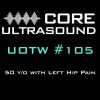The patient is a 32 year old male who has a history of IV drug use, presents as a transfer from an outside hospital (OSH) for sepsis. Was taken to the OSH with bouts of lethargy/AMS mixed with episodes of combativeness. Noted to be febrile, hypotensive. Given 5L NS and a dose of vancomycin PTA. On exam you hear a blowing diastolic murmur. What is the diagnosis and most appropriate management for this patient?

Answer: Severe Aortic Insufficiency, Aortic Valve Vegetation, Cardiogenic Shock
This bedside echo demonstrates a small vegetation on the aortic valve that seems to prolapse during diastole, and color doppler flow demonstrates a large volume of regurgitant blood flow during diastole. Some mitral regurgitation is also noted. The left ventricular (LV) ejection fraction appears to be moderate to severely depressed. B-lines are present on lung ultrasound and the IVC shows no respiratory-phasic changes, suggesting pulmonary edema and a high CVP.
- Acute severe aortic insufficiency (AI) has a high mortality is most commonly caused by bacterial endocarditis, aortic dissection, or blunt chest trauma.1
- Color doppler flow is an easy way to visualize the aortic regurg (AR) jet, and it is considered severe when it occupies 65% of aortic outflow tract width. However, this method underestimates the severity when the AI jet is eccentric or when a bicuspid aortic valve is present.2 To improve the echocardiogram frame rate and subsequent regurgitant flow visualization, make the color doppler box and total ultrasound wedge only as large as they need to be to cover the region of interest.
- Premature mitral valve (MV) closure is a specific and sensitive noninvasive indicator of acute severe AI.3 Measurement of the mitral valve from a parasternal long axis view with simultaneous ECG
 tracing allows this measurement to be easily performed. Mild AI causes the MV to close around 50 msec before the Q wave, while severe AI will result in the mitral valve closing 200 msec or more before the Q wave on the tracing.4 Most ultrasound machines allow the user to hook up ECG leads so that this measurement can be made.
tracing allows this measurement to be easily performed. Mild AI causes the MV to close around 50 msec before the Q wave, while severe AI will result in the mitral valve closing 200 msec or more before the Q wave on the tracing.4 Most ultrasound machines allow the user to hook up ECG leads so that this measurement can be made. - Another simple way to assess the degree of AI is to measure the pressure half time (PHT). This is obtained by measuring a continuous wave doppler signal across the regurgitant jet from an apical view. The PHT is the amount of time that it takes for the jet velocity to reach 70% of its peak. A PHT > 500
 ms corresponds to mild AR, whereas a PHT < 200 ms denotes severe AR.5 Most modern ultrasound machines will easily perform this calculation.
ms corresponds to mild AR, whereas a PHT < 200 ms denotes severe AR.5 Most modern ultrasound machines will easily perform this calculation. - Remember that when using the E-point septal separation to estimate the ejection fraction (EF), aortic regurgitation will blow the anterior mitral leaflet down and falsely increase this measurement. Other methods of EF estimation should be employed in this setting.
- The management of patients with severe AI can be tricky, and the clinician should be aware that medical therapy is only temporizing until a definitive surgical solution is initiated. Emergent valve replacement is usual treatment, and should not be delayed even in the setting of an infected valve.6
- In the setting of severe AI, the volume of regurgitated blood is higher the longer the heart is in diastole.7 Since the time spent in diastole decreases as heart rate increases, the patient may show improvement when kept tachycardic. Pressor choice should take this into account, so dopamine and epinephrine are better choices than norepinephrine. AV nodal blocking agents should be avoided. The heart rate range shown to optimize hemodynamics in these patients has been shown to be 110-130 BPM.8
- However, increasing afterload can also exacerbate the degree of AI, so it is reasonable to assume that if necessary, pressors should be titrated to clinical signs of perfusion (ie awake mental status) rather than an absolute MAP. If patients are hypertensive, as can be the case in chronic AI, nitroprusside can be used to decrease afterload to ameliorate AI and buy the patient some time while they await the OR.1
- Severe LV dysfunction cannot be augmented with an aortic balloon pump, as it will exacerbate the already severe AI.1 In this setting, inotropes such as dobutamine could improve stroke volume.
Our patient received emergent cardiology and cardiothoracic surgery consults. He was taken to the OR within 1 hour of arrival and had successful emergent aortic valve replacement. His hemodynamics subsequently improved and he was taken to the ICU.
 If you like the ultrasound education you get from UOTW, you will absolutely love CastleFest, a world class ultrasound event held in April. Whether you’re an ultrasound novice or want to hone your experienced skills, come eat, drink and learn with the best educators in the field: Dawson, Mallin, Weingart, Mallemat, and more. Oh, and I’ll be there too. Register now.
If you like the ultrasound education you get from UOTW, you will absolutely love CastleFest, a world class ultrasound event held in April. Whether you’re an ultrasound novice or want to hone your experienced skills, come eat, drink and learn with the best educators in the field: Dawson, Mallin, Weingart, Mallemat, and more. Oh, and I’ll be there too. Register now.
REFERENCES
- Bekeredjian R. Valvular Heart Disease: Aortic Regurgitation. Circulation. 112(1):125-134. 2005. [article]
- Perry GJ, Helmcke F, Nanda NC, Byard C, Soto B. Evaluation of aortic insufficiency by Doppler color flow mapping. Journal of the American College of Cardiology. 9(4):952-9. 1987. [pubmed]
- Hamirani YS, Dietl CA, Voyles W, Peralta M, Begay D, Raizada V. Acute Aortic Regurgitation. Circulation. 126(9):1121-1126. 2012. [article]
- Pridie RB, Benham R, Oakley CM. Echocardiography of the mitral valve in aortic valve disease. British heart journal. 33(2):296-304. 1971. [pubmed]
- Lancellotti P, Tribouilloy C, Hagendorff A. European Association of Echocardiography recommendations for the assessment of valvular regurgitation. Part 1: aortic and pulmonary regurgitation (native valve disease). European journal of echocardiography : the journal of the Working Group on Echocardiography of the European Society of Cardiology. 11(3):223-44. 2010. [pubmed]
- Badar AA, Brunton AP, Mahmood AH. The management of patients with aortic regurgitation and severe left ventricular dysfunction: a systematic review. Expert review of cardiovascular therapy. 13(8):915-22. 2015. [PDF]
- Judge TP, Kennedy JW, Bennett LJ, Wills RE, et al. Quantitative Hemodynamic Effects of Heart Rate in Aortic Regurgitation. Circulation. 44(3):355-367. 1971. [article]
- Meyer TE, Sareli P, Marcus RH, Patel J, Berk MR. Beneficial effect of atrial pacing in severe acute aortic regurgitation and role of M-mode echocardiography in determining the optimal pacing interval. The American journal of cardiology. 67(5):398-403. 1991. [pubmed]




